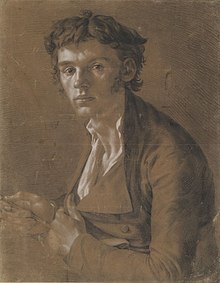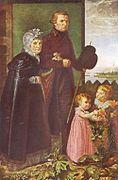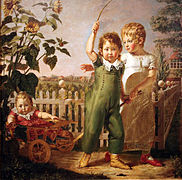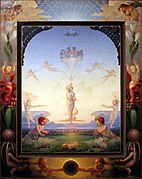Philipp Otto Runge
Philipp Otto Runge (born July 23, 1777 in Wolgast , † December 2, 1810 in Hamburg ) was next to Caspar David Friedrich the most important German painter of the early Romantic period .
Life

Philipp Otto Runge was born in the sea and trading town of Wolgast in Swedish Pomerania as the ninth of eleven children of the married couple Daniel Nikolaus Runge (1737-1825) and Magdalena Dorothea (1737-1818), daughter of the farrier Daniel Christian Müller. The paternal grandfather, Nicolaus Runge (1700–1766), came from a Rügen peasant family, settled in Wolgast after 1720 and acquired citizenship in 1729 . The artist's father, Daniel Nikolaus, was a merchant and shipowner. His son, who developed pulmonary tuberculosis at an early age, was originally supposed to follow in his father's footsteps, but was able to achieve his wish to become a painter.
In 1789 Runge attended the Wolgast school, the director of which was Ludwig Gotthard Kosegarten . Runge fell seriously ill in 1792 and moved to Hamburg with his eldest brother Daniel in 1795 to begin an apprenticeship as a businessman in his “commission and shipping business”. His brother's circle of friends, which included the poet Matthias Claudius , the publisher Justus Perthes and the art collector Johannes Michael Speckter , as well as his encounter with Friedrich Gottlieb Klopstock , encouraged Runge to draw and study ancient authors.
After first drawing lessons in 1797 by Heinrich Joachim Herterich and Gerdt Hardorff the Elder . Ä. In Hamburg he studied from 1799 to 1801 at the Royal Academy in Copenhagen with Jens Juel as well as nude and antique copies, free hand drawing, anatomy, geometry and perspective with Nicolai Abildgaard , a teacher of Thorvaldsen . Afterwards he studied from 1801 to 1804 with Anton Graff in Dresden at the art academy , where he made contact with the Romantics, especially Caspar David Friedrich and Johann Gottfried Quistorp . The poet Ludwig Tieck , whom he met in Dresden, imparted the mysticism of Jakob Boehme to him and made him familiar with Novalis ' views . On a trip to Weimar he met Johann Wolfgang von Goethe .
In the summer of 1801, Philipp Otto Runge and Pauline Susanna Bassenge (born September 18, 1785 in Dresden; † April 26, 1881 in Hamburg) met for the first time in Dresden. The daughter of the glove manufacturer Charles Frédéric Bassenge of Huguenot descent was not yet sixteen at the time. Initially, the father firmly refused his daughter's association with Runge - it was not until April 1803 that he agreed to an engagement. On April 3, 1804, Pauline and Otto married in Dresden. The couple moved to Hamburg and they had four children. The youngest child was born the day after Runge's death and was given his father's first name. Philipp Otto Runge died of tuberculosis .
Work
Throughout his life, Runge pursued the handicraft of paper cutting and, for example, sent Goethe numerous flowers for decorating the room, including instructions for attaching and storing the cuts. Some contemporaries appreciated his paper cuttings. Johanna Schopenhauer admired his silhouettes so much that she tried to cut in Runge's manner herself. In 1805 he achieved his artistic breakthrough with etchings for his paper cuttings in the cycle The Times . This was published in a first edition of 25 pieces. Goethe bought a copy and used it to decorate his music room with the assessment: "To get mad, great and beautiful at the same time."
Runge, who opposed academic painting based on a subject, is next to Friedrich the most important painter of North German Romanticism. Together with Friedrich he represents the North German Early Romanticism. He was more preoccupied with figurative painting than Friedrich and, above all, as a portraitist he created remarkable things ( Die Hülsenbeckschen Kinder , 1806). As an art theorist, he expressed revolutionary ideas for the time and developed his romantic conception of art in his "bequeathed writings". Inspired by Ludwig Tieck's artist novel Franz Sternbald's Wanderings , Runge developed a speculative conception of the “landscape” as a large “hieroglyph”; H. Allegory or symbol (examples: The two versions of The Morning , Arion's Voyage to the Sea , The Times ). According to Runge, the “deepest mysticism of religion” could only be expressed in the new art of a special “landscape” that he had in mind, which constitutes the core of his romantic art conception. Runge was inspired by the vision of uniting painting, poetry, music and architecture in a total work of art, thereby breaking new artistic territory.
Runge's landscape and his concept of artistically designing the entire human environment make him a pioneer of the total work of art . Runge made contributions to German literature by composing several poems. He wrote the two fairy tales Van den Machandelboom and Van den Fischer and siine Fru and made them available to the Brothers Grimm .
Runge contributed to the theory of art through his writing Color Ball , about which he corresponded with Johann Wolfgang von Goethe. He created the first three-dimensional color system .
Runge became the fictional character in The Flounder by Günter Grass . Runge exchanged letters with Clemens Brentano , which was published as a book in 1974, edited by Konrad Feilchenfeldt .

Honors
- His birthplace in Wolgast is now a small museum under the name Rungehaus .
- Runge's grave is located after its reburial in 1935 from the burial place of St. Petri Church (part of the former Dammtorfriedhöfe ) in the Althamburg Memorial Cemetery, part of the Ohlsdorf cemetery in Hamburg. The grave stele there with a portrait relief was created in 1953/54 by the German sculptor Egon Lissow (1926–1990) after a self-portrait by Runge.
- The Wolgaster school was on 14 July 2001 after a survey of all students in Runge-Gymnasium Wolgast renamed
- In memory of Runge, the North German Romantic Route has existed since 1997 . The 54 km long nature trail connects a total of ten life and motif stations of early romantic painters from the region from Greifswald to Wolgast .
- In Hamburg-Barmbek-Nord , Rungestrasse was named after Philipp Otto Runge in 1929 and Rungestieg in 1930 .
Works
Three important works by Runge were destroyed in the major fire of the Munich Glass Palace in 1931 . In the Hamburger Kunsthalle , where the exhibition Runge und seine Zeit took place in 1977/78 , you can find almost all of Runge's surviving works. Some of his works are also in the possession of the cultural history museum of the city of Stralsund and in the Pomeranian State Museum Greifswald. On the occasion of the 200th anniversary of his death on December 2, 2010, the exhibition Kosmos Runge. The morning of romance opens. The exhibition then went to the art gallery of the Hypo-Kulturstiftung in Munich .
|
|
Exhibitions
- 1977/1978: Runge in his time , Hamburger Kunsthalle
- 2010: The birth of romanticism in Pomerania : Friedrich, Runge, Klinkowström , Pommersches Landesmuseum , Greifswald
- 2010/2011: Cosmos Runge. The morning of romance , Hamburger Kunsthalle , Hamburg, followed by the Kunsthalle of the Hypo-Kulturstiftung , Munich
- 2019: Hamburg School - The 19th Century Rediscovered (April 12 to July 14), Hamburger Kunsthalle
Writings and letters
- Left behind writings . Edited by JD Runge. 2 volumes. Friedrich Perthes, Hamburg 1840–41 (Volume 1 contains essays on art and literary work, Volume 2 the correspondence with Brentano, Arnim, Goethe and Tieck).
- Phillip Otto Runge's correspondence with Goethe . Edited by Hellmuth von Maltzahn . Weimar 1940.
- Clemens Brentano - Philipp Otto Runge: Correspondence . Edited by Konrad Feilchenfeldt . Frankfurt / M. 1974.
- Philipp Otto Runge: Letters and Writings . c. H. Beck, Munich 1982. ISBN 3-406-08534-2
- Color ball . Construction of the ratio of all mixtures of colors to each other and their complete affinity; with notes on the color and the correspondence with Goethe. Stuttgart-Bad Cannstatt 1999.
- Philipp O. Runge, Jacob Grimm , Wilhelm Grimm : From the Machandelboom - From the fisherman un syner Fru . Trier 2008 (text-critical edition).
- Letters about art . Edited by Peter Betthausen . Leipzig 2010.
literature
- Markus Bertsch; Regine Gerhardt (Ed.): Kosmos Runge. The morning of romance . Exhibition catalog. Hirmer, Munich 2010. ISBN 978-3-7774-3061-4
- Gerhard Dallmann: Philipp Otto Runge: ... stop admiring . Novel biography. Husum Verlag, Husum 2009. ISBN 978-3-89876-447-6
- Curt Grützmacher : Novalis and Philipp Otto Runge: Three central motifs and their sphere of meaning: The flower - the child - the light (dissertation), Eidos Verlag [WP Fink], Munich 1964.
- Jens Christian Jensen : Philipp Otto Runge. DuMont, Cologne 1977. ISBN 3-7701-0907-4
- Peter Kränzle: RUNGE, Philipp Otto. In: Biographisch-Bibliographisches Kirchenlexikon (BBKL). Volume 8, Bautz, Herzberg 1994, ISBN 3-88309-053-0 , Sp. 996-1011.
- Renate Krüger : The day from morning and evening . A novel biography in five pictures. Union, Berlin 1977.
- Michael Lingner : The musicalization of painting with Ph. O. Runge. On the prehistory of the spiritualization of art. In: Zeitschrift für Ästhetik und Allgemeine Kunstwissenschaft, Volume 24-1 / 1979 ISSN 0044-2186 ( full text ).
- Michael Lingner: Is PO Runge's romantic artist ethos too idealistic? A look from the present into the past and future. Can one work for art and live from art? In: Bertsch, M. et al. (Ed.): Kosmos Runge. The Hamburg Symposium. Hamburger Kunsthalle 2013. p. 351 ff. ( Full text )
- Heinz Matile: The color theory of Philipp Otto Runge. A contribution to the history of artist color theory . Preface by Jörg Traeger . Mäander, Mittenwald 1979. ISBN 3-88219-070-1
- Theodor Pyl : Runge, Philipp Otto . In: Allgemeine Deutsche Biographie (ADB). Volume 29, Duncker & Humblot, Leipzig 1889, pp. 692-694.
- Cornelia Richter (arrangement): Philipp Otto Runge. I know a beautiful flower . Schirmer / Mosel, Munich 1981. ISBN 3-921375-65-7 , catalog raisonné of the paper cuts
- Thomas Sello: We have to become children if we want to achieve the best . In: Lichtwark booklet No. 75. Verlag HB-Werbung, Hamburg-Bergedorf, 2010. ISSN 1862-3549 .
- Jörg Traeger : Philipp Otto Runge and his work . Prestel, Munich 1975. ISBN 3-7913-0361-9
- Jörg Traeger: Runge, Philipp Otto. In: New German Biography (NDB). Volume 22, Duncker & Humblot, Berlin 2005, ISBN 3-428-11203-2 , pp. 264-267 ( digitized version ).
- Christoph Vitali (Ed.): Serious games. The spirit of romanticism in German art 1790-1990 . Oktagon Verlag, Stuttgart 1995.
- Stephan Waetzoldt: The heavenly child in Ph. O. Runge's “Tomorrow”. In: Lichtwark No. 2. Ed. Bergedorf District Office, Bergedorf, 1950. See now: Verlag HB-Werbung, Hamburg-Bergedorf. ISSN 1862-3549 .
Web links
- Literature by and about Philipp Otto Runge in the catalog of the German National Library
- Works by and about Philipp Otto Runge in the German Digital Library
- Literature about Philipp Otto Runge in the state bibliography MV
- Works by Philipp Otto Runge at Zeno.org .
- Works in the Web Gallery of Art
- Philipp Otto Runge Foundation
- Hamburger Kunsthalle gallery 19th century
- Left behind writings by Philipp Otto Runge in the Archive System Kunst ask23! in Hamburg.
- Vita Pauline (Susanna) Runge.
Individual evidence
- ↑ a b c Philipp Otto Runge. Paper cutouts. Schirmer / Mosel, Munich 2010, p. 115
- ↑ Süddeutsche Zeitung: Romanticism is returning . Number 105, 7./8. May 2011, page 22
- ↑ Cosmos Runge
- ↑ Runge's color ball
- ^ Grave of Philipp Otto Runge at the Althamburg Memorial Cemetery, part of the Ohlsdorf cemetery at knerger.de
- ↑ fof ohlsdorf.de/kulturgeschichte
- ↑ Homepage of the Runge-Gymnasium Wolgast ( Memento of the original from September 13, 2017 in the Internet Archive ) Info: The archive link was inserted automatically and has not yet been checked. Please check the original and archive link according to the instructions and then remove this notice.
- ↑ Rita Bake : A Memory of the City. Streets, squares, bridges named after women and men , Volume 3, as of December 2017, pp. 1037, 1038 ( PDF file )
- ↑ FAZ of September 21, 2010, page 33: The three musketeers of romanticism
- ↑ Website for the exhibition Kosmos Runge. The morning of romance
| personal data | |
|---|---|
| SURNAME | Runge, Philipp Otto |
| BRIEF DESCRIPTION | German Romantic painter |
| DATE OF BIRTH | July 23, 1777 |
| PLACE OF BIRTH | Wolgast (Swedish Pomerania) |
| DATE OF DEATH | December 2, 1810 |
| Place of death | Hamburg |








